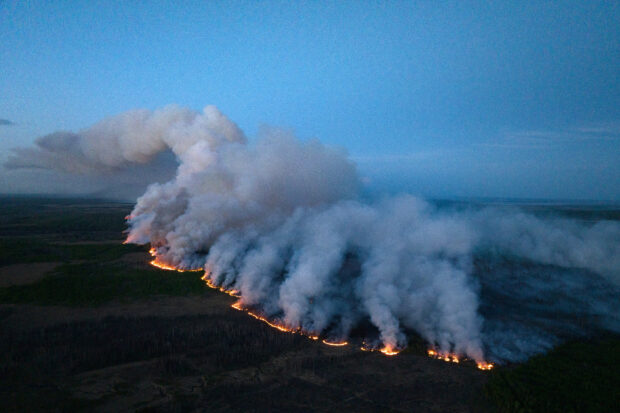Canada’s Alberta blanketed by smoke as wildfire battle continues

Smoke rises from the Stoddart Creek wildfire near Fort St. John, British Columbia, Canada May 13, 2023. B.C. Wildfire Service/Handout via REUTERS
OTTAWA — Smoke blanketed the skies over much of Alberta on Wednesday as firefighters from Canada and the U.S. battled raging wildfires that have prompted evacuations, disrupted rail service and shut energy production in Canada’s main oil-producing province.
Hot and dry conditions have triggered an intense and early start to wildfire season in Alberta. As of Wednesday, there were 91 wildfires burning in the forest protection area of Alberta, including 27 out of control.
A cold front this week eased historically high temperatures and helped firefighting, which led authorities to lift some evacuation orders on Tuesday. The number of evacuees has dropped to about 12,000 from a peak of more than 30,000 people earlier this month, Alberta officials said at a briefing on Wednesday.
Still, lack of rain and higher temperatures forecast for later this week mean conditions for wildfires remain extremely volatile, Alberta’s Public Safety Minister Mike Ellis said at the briefing.
The cold front brought strong winds that have carried wildfire smoke to neighboring provinces and left a large part of Western Canada with poor air quality.
Article continues after this advertisement“It’s clear that the smoke from these fires continues to be a concern for both health and visibility,” Ellis said, urging people in areas of very poor air quality to stay indoors.
Article continues after this advertisementAir quality in cities including Calgary has deteriorated to category 10+, the worst level on Environment Canada’s Air Quality Health Index, indicating “very high risk.”
Winds are expected to continue to weaken into Wednesday night, but any improvement in air quality will probably be temporary, said Jesse Wagar, a meteorologist with Environment Canada.
“There is some improvement expected, but it’ll likely be short lived just because how many fires there are … we’re likely to have smoke moving from really any direction,” Wagar said.
Concerns about the wildfires have also led to benchmark Canadian heavy crude prices to rise to their highest levels in months.
On Wednesday, consultancy firm Rystad Energy said nearly 2.7 million barrels per day (bpd) of Alberta oil sands production in May is at risk in “very high” or “extreme” wildfire danger rating zones.
Of estimated May production volumes, about 60% are currently subject to extreme wildfire danger levels, with the remaining 40% subject to very high danger, Oslo-based Rystad said.
More than 2,500 firefighters, including personnel from Canadian and U.S. agencies as well as the Canadian army, were battling the wildfires in Alberta.
The widespread blazes have put Alberta Premier Danielle Smith’s disaster management skills – as well as her party’s policies – under the microscope ahead of a provincial election on May 29.
The province has issued a plea to some 20,000 public servants, encouraging anyone with firefighting experience to volunteer to battle the blazes, the Toronto Star newspaper has reported, citing an email sent to employees.
The wildfire activity has caused rail disruptions, but the impact is unlikely to have credit implications for the Canadian grain handling sector, said Moritz Steinbauer, vice president of diversified industries at ratings agency DBRS Morningstar.